With today's presentation of the first lab grown hamburger by Prof. Mark Post, in-vitro meat makes an important step towards our daily diet. Cultured meat could one day be a sustainable and animal friendly alternative to today's meat production. Yet, despite this technological breakthrough, many people still find it is an unattractive idea to eat meat from the lab. Before we can decide if we will ever be willing to eat in-vitro, we need to explore the food culture it will bring us.
While most of the ongoing research focuses on duplicating current meat products (like hamburgers) and making the cultured beef affordable, sustainable and tasty, the envisioning of new meat products that fit this new technology is equally important. Just like industrial manufacturing brought us new furniture, in-vitro meat technology may lead to entirely new food products, beyond todays sausages, steaks and burgers.
Besides a Hamburger, What Else?
Although cultured meat is typically presented as a technology to solve problems like animal suffering, food scarcity and climate issues, the technology could also be framed positively: Eating in-vitro could bring us entirely new food experiences and eating habits that may enrich our lives.
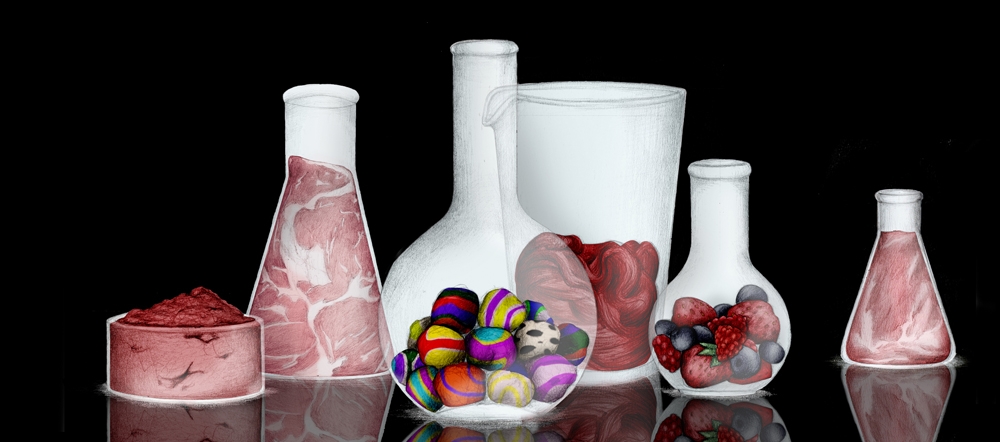
Over the last two years, the Next Nature Lab has been envisioning the new food products and eating habits that may emerge from the in-vitro meat technology. These speculative designs vary from knitted meat, protein powder fondue and luxurious meat fruit, to kitchen based bio-reactors, meat paint and colorful magic meatballs for the kids.
A full overview is to be presented early 2014 in a speculative cookbook of in-vitro meat dishes from which you cannot cook, yet. The book will function as a conversation starter on the future of meat, find more on www.bistro-invitro.com.
1. Magic Meatballs
Magic Meatballs are designed to playfully familiarize children with lab-grown meat. Young people are more prone to overconsumption of proteins and fats, and are more sensitive to the hormones and antibiotics used in conventional meat production. Luckily, lab-grown Magic Meatballs can be tailored precisely to a child’s individual needs.
The basic meat consists solely of animal protein, and the combination of fats, omega-3s and vitamins is completely customizable. Colors and flavors can also be added to the neutral base to make the meat change color or crackle in your mouth. Magic Meatballs actively involve kids with the meat they eat, so that future generations will more readily accept protein grown in labs.
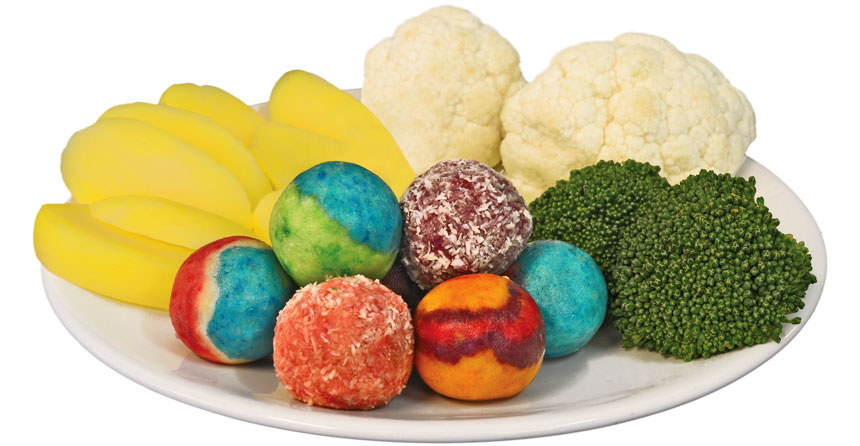 Magic Meatballs, designed by Mark Kanters, Feasibility: High.
Magic Meatballs, designed by Mark Kanters, Feasibility: High.
2. Knitted Meat
Rather than growing whole steaks in bio-reactors, Knitted Meat assumes that it is more feasible to create thin threads of protein. Supermarkets sell balls of meat fiber seasoned with various spices and vegetable flavors. New kitchen appliances enable consumers to weave meat according to preset preferences. Texture, taste and tenderness can be controlled to create a personal, multisensory eating experience. Groups of diners can even knit their own sections of a protein scarf, enabling multiple people to share a unique moment.
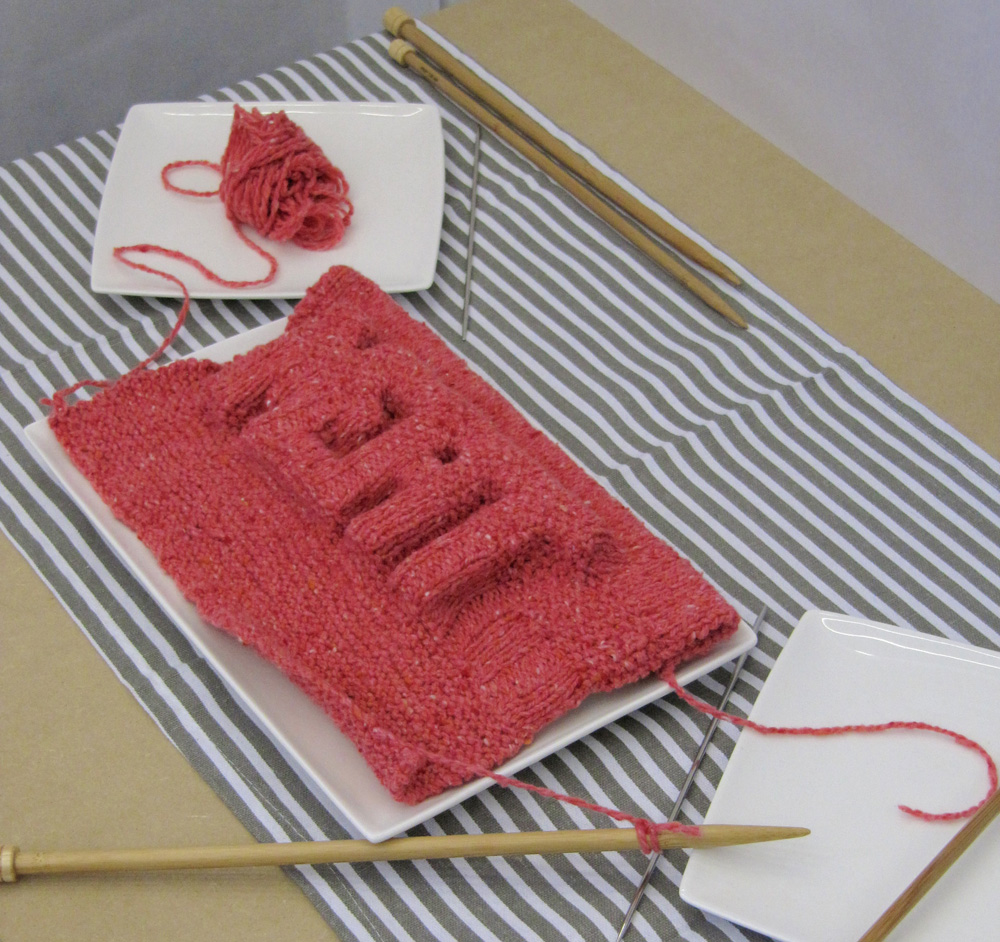 Knitted Meat, designed by Alberto Gruarin, feasibility: Medium.
Knitted Meat, designed by Alberto Gruarin, feasibility: Medium.
3. Kitchen Meat Incubator
The Kitchen Meat Incubator does for home cooking what the electronic synthesizer did for the home musician. It provides its users with a set of pre-programmed samples that can be remixed and combined to their liking. Besides the preparation of traditional styles like steak, sausage or meatballs, consumers can bring their own imagination to the meat preparation process. The handy sliders on the device control size, shape and texture. More expensive models of the Kitchen Meat Incubator also come with a wireless link that allows you to download meat recipes from the internet or share them with friends.
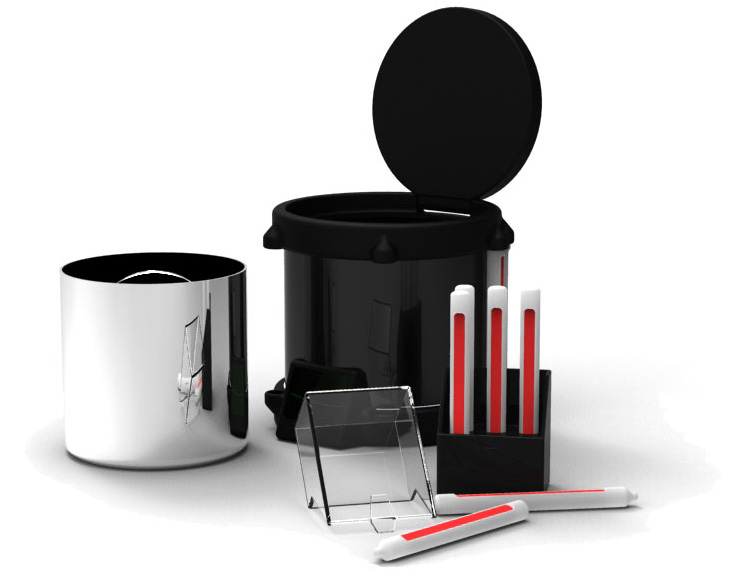 Kitchen Meat Incubator, designed by Daniel Ong, feasibility: Low
Kitchen Meat Incubator, designed by Daniel Ong, feasibility: Low
4. Meat Fruit
La Pâte Meat Fruit aims to seduce and inspire diners with an entirely new eating experience that balances eating meat and fruit. In vitro technology is used to grow meat structures that precisely mimic those of various existing fruits such as berries, oranges, and mangoes. The result is used to create La Pâte, a sweet-savory amuse-bouche ideal for Michelin-starred restaurants. Besides the joy of fusing fruit and meat into one exclusive hypernatural dining experience, meat-fruit is also a celebration of our unisex culture. In contrast to our prehistoric past where men hunted and women gathered, we now live in a post-masculine, post-feminist society where gender doesn’t matter like before. Meat-fruit exemplifies the perfect blend between male and female.
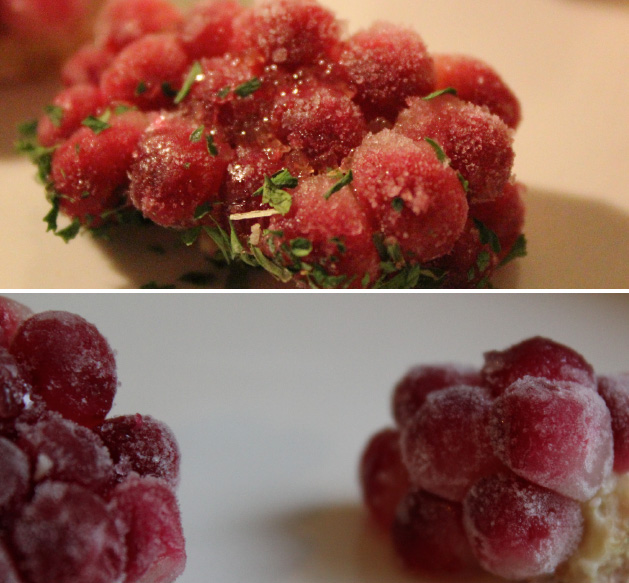 Meat Fruit, designed by Aylin Groenewoud, feasibility: Low
Meat Fruit, designed by Aylin Groenewoud, feasibility: Low
5. Paint with Meat!
Meat paint is a food product for children of 5-10 years old. It allows them to prepare their own meat dish in a very creative, fun and safe way: by painting! The meat paint lets children put some extra effort into their meal, which makes the dinner more valuable and meaningful again. By painting their own meal children get more affinity with their food and are therefore more willing to eat it.
Like with a regular painting, the child has different colors to paint with. With this paint the child can make anything he or she wants and create something beautiful. Once the drawing is finished the painting is baked for 15 minutes in the oven. So it’s not just your child’s beautiful creation, it becomes a tasty meat dish too which the entire family can enjoy and eat!
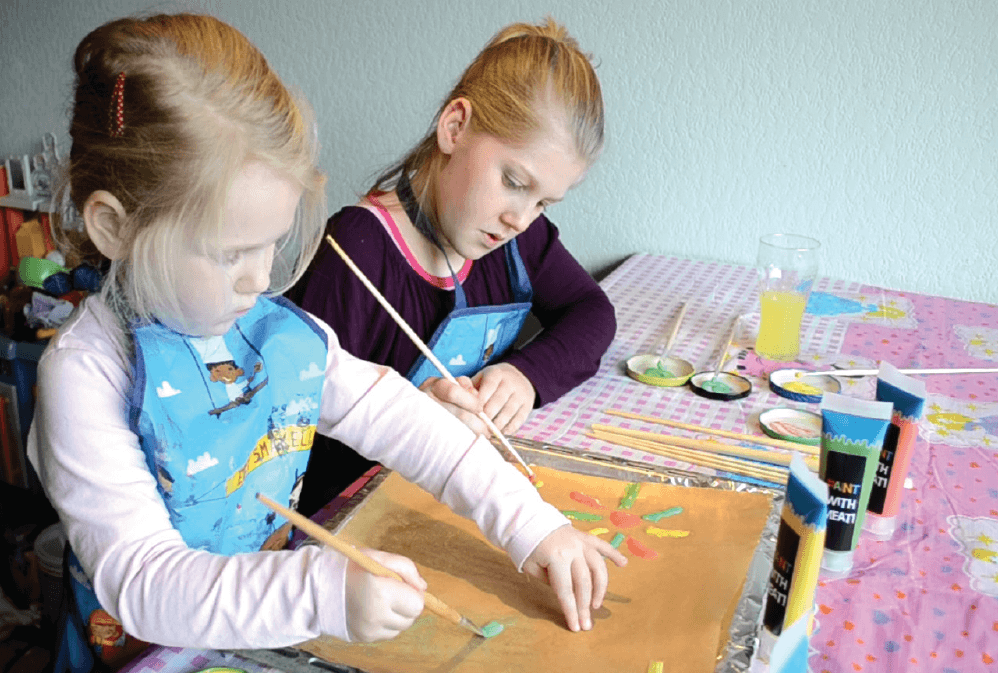 Meat Paint, designed by Ilse Maessen, feasibility: high
Meat Paint, designed by Ilse Maessen, feasibility: high
6. Meat Powder
The number one argument for eating meat: it provides nutritious proteins that cannot be entirely supplied by vegetarian alternatives. Like it or not, humans are omnivores. Meat is a nutritious source of proteins and vitamins that vegetarian alternatives struggle to supply. Thanks to Meat Powder, we can transcend our barbaric impulses and history of animal cruelty. Meat Powder is a straightforward form of in vitro meat that provides the proteins you need – no more, no less. Meat Powder can be used in soups, pies and salads, but is best used in a creamy meat fondue. Like the traditional cheese fondue, the meat fondue is a social dish best served at special occasions. Pure, fun, and 100% victimless.
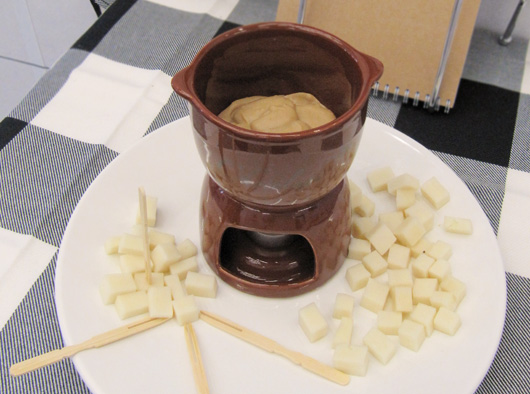 Meat Powder, designed by Costanza Giuffrida, feasibility: High
Meat Powder, designed by Costanza Giuffrida, feasibility: High
7. Rustic In Vitro
Many people still find in vitro meat too alien and artificial to put it in their mouths. With the Rustic In Vitro incubator, this outdated perception is about to change. Similar to old-fashioned sausages and hams hung to cure in the butcher’s or at home, Rustic In Vitro is grown in a familiar-looking incubator that reminds us of the good old days. Rustic In-Vitro incubators come in various shapes designed to simulate rabbit, boar or cattle. The more time it has to ripen, the more structure and character the replicating meat cells will develop. Progressive nostalgia ahoy!
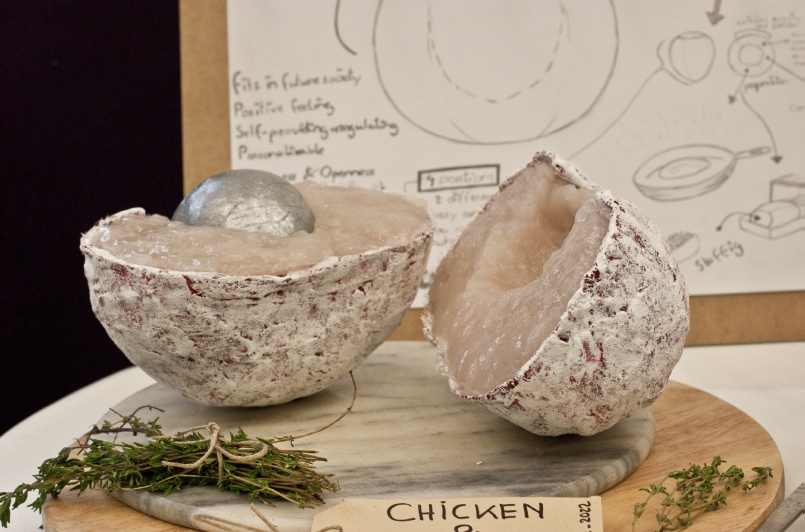 Rustic In-vitro, designed by Marjolein Kors, feasibility: low
Rustic In-vitro, designed by Marjolein Kors, feasibility: low
The speculative Meat Visions were developed in the Next Nature Lab at Eindhoven University of Technology. The projects were coached by Menno Stoffelsen, Ronald van Tienhoven, Cor van der Weele, Daisy van der Schaft, Arne Hendriks, Janine Huizinga, Joris van Gelder, Mike Thompson and Koert van Mensvoort. The In-vitro Cookbook will be compiled by Hendrik-Jan Grievink, Allison Guy, Silvia Celiberti and Koert van Mensvoort. Top illustrations were made by Silvia Celiberti and K. Cheng.
Do you want to know more about the future of meat? We are writing a speculative cookbook of in-vitro meat dishes, join us on www.bistro-invitro.com.
Carlos
I don't like it... puaj
Posted on
severine
very interesting ideas! I think the main challenge with the development of synthetic meat is not the technological issues (cost, mass production, safety ...) but rather the people acceptance . Today, most people are disgusted by the idea of eating in vitro meat (the "yuck factor" is clearly involved here...) so there is really a lot of educational, marketing and design work to do. Maybe one keypoint is the involvement of the customer in the process. Could we imagine in the future to directly grow our meat at home ? It will give us the same kind of satisfaction that eating fruits or vegetables grown in our garden...
Posted on
Van Mensvoort
@nagash: Indeed the visions are speculative and mere explorations of the space of opportunities. They are made to help us decide what future we want. That expensive wireless version of the Kitchen Meat Incubator must be a marketing scam to position it in the high end range where people are willing to pay more, don't you think? Furthermore I removed the 'quotes' around 'problem', to avoid any misunderstanding that these issues are very very real. Thanks for the remark!
Posted on
nagash
they all look very promising, but the text don't make it clear if any of those examples were actually prototyped or if they're all just concepts... the most disturbing part is the reference to animal suffering as a "problem" - the quotes mean that you don't see it as a problem at all? to me it's as a problem as slavery or rape :( and I can't agree that "more expensive models of the Kitchen Meat Incubator will also come with a wireless link" as wireless link is already cheap.
Posted on